Currently Empty: $0.00

In the world of cybersecurity, threats are rapidly evolving and challenging defense strategies.
It is vital that information security teams are proactive and detect threats in advance.
Threat intelligence tools play a critical role in optimizing security operations in this evolving risk environment.
Importance of Threat Intelligence
The global cyber threat landscape is constantly changing, which is why threat intelligence has become the cornerstone of defense mechanisms. For cybersecurity experts, this intelligence is a key factor in understanding the nature and source of the threats they face. In complex cyberattack scenarios in particular, ensuring security without threat intelligence is nearly impossible.
This intelligence provides analysis and predictions to detect harmful activities at an early stage and protect organizations from future attacks. It serves as a strategic guide for prioritizing measures to be taken by cybersecurity teams during threat hunting and incident response processes. With these tools, security experts can quickly access structured and analysis-ready data about threats, analyze it in depth, and strengthen security protocols.
Implementing an effective threat intelligence approach contributes to increasing cyber resilience. This approach raises awareness among organizations about complex and advanced threat vectors while enabling the development of proactive defense strategies. In conclusion, threat intelligence plays a vital role in ensuring protection at the forefront of cybersecurity. For more information on this topic, please refer to our article on Cyber Threat Intelligence Training.
Proactive Approach to Cyber Security
A proactive approach to cybersecurity increases intervention capacity by detecting potential threats early on and reduces the likelihood of damage. This approach requires advance preparation.
To reduce risks and strengthen security mechanisms, proactive defense involves continuously reviewing network analysis, behavioral monitoring, and firewall configurations. Although laborious, this reduces costs and risks in the long run.
Organizations in Turkey face an average of 14 million cyber threats per year.
At the core of a proactive approach lies continuous education and awareness; employees are informed about cyber hygiene and encouraged to be vigilant against current threats. Additionally, regular penetration tests and proactive identification of security vulnerabilities play a critical role in minimizing the attack surface. If you want to learn more about how to develop proactive defense strategies, check out our article on Secure Development Process in Cybersecurity with DevSecOps.
Roles and Responsibilities of Threat Intelligence
Threat intelligence plays a strategic role in preventing security incidents and is critical in the ever-evolving cyber threat landscape. This process enables the early detection and prevention of threats, strengthening an organization’s security posture.
Analyzing threat actors’ tactics, techniques, and procedures (TTPs) is a fundamental responsibility of intelligence professionals. With this information, security strategies can be directed more effectively.
In addition, intelligence teams are responsible for conducting in-depth investigations into malware, intrusion techniques, security vulnerabilities, and their potential impact. Monitoring the emergence of new threat vectors, managing constantly evolving risks, and developing proactive measures against them form the core of intelligence activities.
Threat intelligence activities also play a vital role in providing background information on current incidents that incident response teams are working on. This is key to early intervention and continuous optimization of defense mechanisms in a complex threat landscape. Intelligence units strengthen the organization’s overall “war” readiness and cyber resilience through regular reporting and analytical feedback, promoting a continuous improvement process.
Best Threat Intelligence Tools
The complexity and evolving nature of cyber threats have led to threat intelligence taking on a critical role. In this context, threat intelligence platforms such as MISP (Malware Information Sharing Platform & Threat Sharing), TheHive Project, and OpenCTI (Open Cyber Threat Intelligence) provide cybersecurity professionals with comprehensive data points and analyzed intelligence, enabling them to anticipate current and future cyber threats. These tools not only collect information but also interpret it, laying the groundwork for organizations to develop proactive security strategies.
For more information about the different security tools you can use, check out our article Cyber Security Tools: The Best Free and Paid Tools with CyberSkillsHub.
In addition to automation and integration in the use of threat intelligence tools, customizability to meet specific intelligence needs is also essential. IntelMQ and CIF (Collective Intelligence Framework) add depth to intelligence processes with their intensive data analysis and modulation capabilities. Security infrastructures that integrate these systems gain the ability to respond more quickly and accurately to threat forecasts.

Open Source Intelligence Tools (OSINT)
Open source intelligence is the foundation of threat analysis.
OSINT tools have become an integral part of threat hunting for security experts. The primary purpose of such tools is to collect and analyze critical information from the depths of the internet. This information can be data obtained from social media platforms, forums, news sites, and other open sources. At the same time, this data plays a key role in interpreting and tracking the emergence patterns of cyber attacks.
OSINT is important in the early detection of cyber threats.
Many tools, such as Maltego and Shodan, which are considered essential for cyber experts, have come to the fore in vulnerability research and cyber asset tracking by offering extensive databases and powerful query capabilities. These tools provide users with extensive opportunities for discovering network structures and performing correlation analysis.
The capabilities of OSINT tools meet the needs of users.
OSINT tools, which are extremely diverse and constantly evolving, have become a central element of threat intelligence strategies. Regular updates to these tools and their adaptation to the insights of the security community indicate that their importance will continue to grow in 2024. The constant evolution of methods and sources used in intelligence gathering makes the capabilities of these tools even more critical.
Network-Based Threat Detection Systems
Organizations use various systems to ensure network security.
Network-based threat detection systems (NTDS), which continuously analyze network traffic and identify suspicious activities, play a central role in the cybersecurity ecosystem. These systems detect anomalies in an organization’s network traffic to identify potential attacks at an early stage. Particularly effective in providing protection against unknown threats such as zero-day attacks, these systems are a cornerstone of proactive defense.
Network traffic is a source of data for threat hunting.
NTDSs that use artificial intelligence and machine learning are highly advanced in pattern recognition and anomaly detection. These systems save security experts time by distinguishing attack attempts from complex data sets and generating alarms.
Real-time monitoring and automatic intervention enhance defense capabilities.
NTDSs detect security breaches and potential threats by processing detailed log records and modeling network behavior. This process enables security experts to respond quickly. To better understand the basics of network security and how firewalls work, check out our article What is a Firewall and How Does It Work? To keep pace with the ever-evolving cyber threat landscape, NTDSs must have access to continuously updated threat signatures and behavior-based detection algorithms. This process necessitates that organizations adopt a dynamic and flexible approach to their network security strategies.
Effective Vehicle Usage Strategies
Effective use of threat intelligence tools requires regular integration of updated threat databases and intelligence feeds. This means responding dynamically to changes in the security environment and staying alert to unexpected attack vectors. Cyber Threat Intelligence (CTI) tools with customized rules and machine learning-based detection mechanisms play a critical role in this continuity.
In order for organizations to effectively utilize threat intelligence tools, it is important to establish multidisciplinary teams to integrate perspectives from various areas of expertise. For example, collaboration between information technology, security operations, and risk management departments promotes coordinated and rapid response to security incidents. This approach contributes to the improvement of incident response plans and the adoption of best practices as institutional memory.

How to Choose the Right Tool?
When selecting threat intelligence tools, the organization’s security requirements should be taken into account. Tools that are appropriate for the risk profile and sensitivity level that have been prioritized should be preferred. During this process, attention should be paid to the organization’s existing security infrastructure integration capacity and technical support capabilities.
Systems that can analyze high-volume data streams, have advanced threat hunting capabilities, and automate incident response processes should be preferred. In addition, care should be taken to ensure that they have features that facilitate intelligence sharing and collaboration. This speeds up information exchange with other organizations and provides access to a broad threat database. The tools used must be compatible with continuously updated threat databases, which is critical for timely threat detection.
The decision-making process should also include a cost-effectiveness analysis of the tool to be used. License costs, training expenses, and maintenance and repair requirements for the application should be taken into consideration. In the long term, total cost of ownership and operational efficiency are among the important factors affecting the return on investment.
When evaluating all these factors, the competence level and adaptation process of the security team should be taken into consideration. User-friendly interfaces and training materials for the tools to be used are essential requirements for team members to be able to use the tool effectively and efficiently. Therefore, technology choices should be structured in line with the security team’s current competencies and development needs. This will ensure that the tool can be used sustainably and effectively within the organization.
Importance of Vehicle Integration and Automation
The integration of cybersecurity tools enables fast and effective analysis of data from different sources. This is key to developing a coordinated defense strategy against threats.
Automation accelerates threat detection and response processes and reduces human error. This is a factor that increases the efficiency of security teams.
Integrated tools enable continuous monitoring of security operations, capturing early warning signs of complex cyber threats. This is crucial for adopting a proactive defense approach. In addition, automation allows for standardization of information processing and response processes, which provides critical benefits in terms of consistency and speed.
Vehicle integration and automation play a vital role in enhancing operational capabilities in an ever-evolving cyber threat landscape. Automating security tools makes the amount of data that needs to be analyzed manageable, thereby simplifying threat hunting and incident response processes. This also allows security teams to focus on high-level skills such as critical thinking and strategic planning, thereby increasing overall cyber defense effectiveness.
Trends and Future Vision for Threat Intelligence
In the world of cybersecurity, the use of artificial intelligence and machine learning technologies is becoming increasingly integrated. These innovations are improving and accelerating analysis processes by automating threat intelligence.
Systems equipped with deep learning mechanisms and the ability to predict zero-day attacks will form the basis of future threat intelligence infrastructure. In addition, with the adoption of blockchain technology, threat data will be protected against fraud, and secure sharing capabilities will continue to increase thanks to distributed ledger technology.
In data collection and analysis methods, the use of automation and AI-supported solutions is expected to minimize human error and make processes more dynamic. This will also be an important development that will enable more accurate and rapid action in threat hunting.
Artificial Intelligence-Powered Solutions
Artificial intelligence is one of the cornerstones of threat intelligence and plays an important role in its ever-increasing complexity.
- Anomaly Detection: AI-powered systems can detect security breaches early by identifying abnormal activities in network traffic.
- Automatic Behavior Analysis: Analyzing the behavioral characteristics of malicious software is critical for detecting unknown threats.
- Predictive Analysis: Artificial intelligence can compile pre-attack indicators to make predictions and provide proactive security.
- Quick Decision Making: Automatic decision-making mechanisms enable rapid response to threats.
- Continuous Learning: Machine learning keeps itself up to date by continuously learning new threat scenarios and improving security systems. These cloud-based solutions enable organizations to extract meaningful information from ever-expanding data sets.
Artificial intelligence algorithms continuously improve threat intelligence while adding value to the decision-making processes of cybersecurity experts.
Real-Time Analysis and Response Mechanisms
The dynamic nature of the cyber threat environment requires real-time analysis and response capabilities for security processes.
- Threat Detection Systems (IDS/IPS): Continuously monitors network traffic to detect suspicious activities and signatures.
- Incident Response Automation: When security breaches are detected, predefined protocols are automatically activated.
- SIEM Tools: Security information and event management tools collect and analyze data to issue alerts against threats.
- Automatic Decision Support Systems: Respond to threats instantly based on rules and algorithms. Properly integrated tools can minimize the impact of threats and prevent potential violations.
Real-time analysis and response mechanisms support threat hunting activities, making the defense line proactive.
Frequently Asked Questions About Threat Intelligence Tools
What is threat intelligence and why is it important?
Threat intelligence is the information and analysis used to understand, prevent, and respond to cybersecurity threats. It enables proactive defense in cybersecurity by helping to detect attacks early and respond to them.
What are the best threat intelligence tools?
Platforms such as MISP, TheHive Project, and OpenCTI are leaders in threat prediction by providing extensive data points and analyzed intelligence. In addition, tools such as IntelMQ and CIF also provide intensive data analysis.
What are open source intelligence (OSINT) tools used for?
OSINT tools are used to collect and analyze critical information from the depths of the internet. This information plays a critical role in interpreting and tracking the emergence patterns of cyber attacks.
How do network-based threat detection systems (NTDS) work?
NTDS continuously analyzes network traffic and identifies suspicious activity. These systems are one of the cornerstones of proactive defense, detecting potential attacks early on.
What is the importance of automation and tool integration in cybersecurity?
Automation speeds up threat detection and response processes while reducing human error. Vehicle integration enables fast and effective analysis of data from different sources, helping to develop a coordinated defense strategy.
How do AI-powered solutions make a difference in threat intelligence?
Artificial intelligence plays a vital role in detecting unknown threats by identifying abnormal activity in network traffic and analyzing the behavioral characteristics of malicious software. It also provides proactive security by collecting pre-attack indicators.
Why are real-time analysis and response mechanisms critical?
The dynamic nature of the cyber threat landscape requires security processes to analyze and respond in real time. This supports threat hunting activities and makes the defense line proactive.







